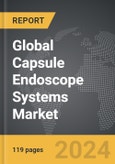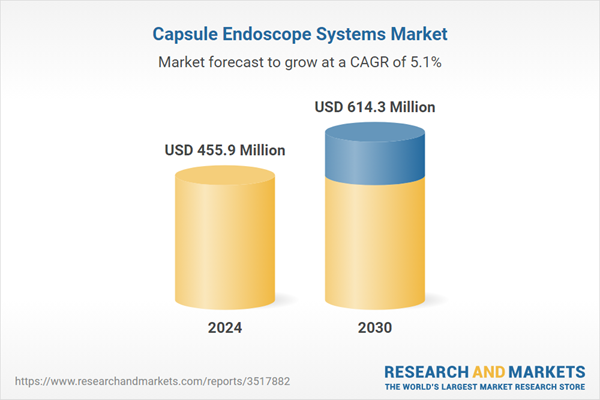Global Capsule Endoscope Systems Market - Key Trends and Drivers Summarized
Capsule endoscopy (CE) has significantly impacted the field of gastroenterology by providing a non-invasive, well-tolerated means for detailed visualization of the gastrointestinal tract, areas that were previously difficult to access. Since its inception, CE has advanced beyond small bowel diagnostics to include exploration of the esophagus and colon. This method is crucial for diagnosing various conditions such as Crohn’ s disease, obscure gastrointestinal bleeding, and small bowel tumors. CE is particularly valued for its ability to deliver clear images of intricate areas of the small intestine, establishing it as a preferred method for investigating small bowel disorders. The technology is typically utilized when traditional methods such as upper and lower GI endoscopies do not yield conclusive results. For certain high-risk patients, pre-procedural evaluations are recommended to minimize the risk of capsule retention, showcasing the careful integration of CE into broader diagnostic protocols.Advancements in CE technology have not only refined its diagnostic capabilities but also expanded its clinical applications. Dedicated esophageal and colon capsule endoscopes have been developed, each tailored to specific parts of the gastrointestinal tract. While esophageal capsule endoscopy is valuable for diagnosing conditions like esophagitis and Barrett’ s esophagus, it lacks biopsy capabilities, somewhat limiting its scope compared to traditional endoscopy. On the other hand, colon capsule endoscopy presents a non-invasive alternative to conventional methods, potentially enhancing colorectal cancer screening and appealing to patients reluctant to undergo traditional procedures. Looking forward, the potential development of maneuverable capsules capable of targeted biopsy or therapeutic interventions could vastly enhance the clinical value of CE, indicating a shift towards more interactive and comprehensive capsule endoscopy technologies in the near future.
The market growth for capsule endoscopy systems is driven by several factors. Technological advancements such as improved battery life, better image quality, and enhanced data transmission have expanded CE's clinical applications and effectiveness. There's also a growing demand for cost-effective diagnostic methods that align with global healthcare objectives to reduce expenditures while improving care. CE is increasingly integrated into comprehensive diagnostic protocols, extending its utility across more gastrointestinal conditions. The integration with digital health records and advancements in artificial intelligence for image analysis are transforming CE, enhancing diagnostic accuracy and efficiency. Moreover, patient safety and comfort with CE’ s non-invasive nature continue to drive its preference over more invasive procedures. As gastrointestinal diseases rise globally, the need for effective diagnostic tools like CE is more pronounced, promoting early and precise diagnoses to improve patient outcomes. The development and adoption of CE are further supported by educational programs, global health initiatives, and strategic collaborations that accelerate technological enhancements and clinical adoption. As CE technologies evolve, they promise to redefine non-invasive gastrointestinal diagnostics and expand therapeutic capabilities, making CE a cornerstone in managing digestive diseases effectively.
Report Scope
The report analyzes the Capsule Endoscope Systems market, presented in terms of market value. The analysis covers the key segments and geographic regions outlined below.- Segments: Product (Small Bowel Capsule, Esophageal Capsule, Colon Capsule); End-Use (Hospitals, Ambulatory Surgery Centers, Other End-Uses).
- Geographic Regions/Countries: World; United States; Canada; Japan; China; Europe (France; Germany; Italy; United Kingdom; Spain; Russia; and Rest of Europe); Asia-Pacific (Australia; India; South Korea; and Rest of Asia-Pacific); Latin America (Argentina; Brazil; Mexico; and Rest of Latin America); Middle East (Iran; Israel; Saudi Arabia; United Arab Emirates; and Rest of Middle East); and Africa.
Key Insights:
- Market Growth: Understand the significant growth trajectory of the Small Bowel Capsule segment, which is expected to reach US$426.9 Million by 2030 with a CAGR of a 5.1%. The Esophageal Capsule segment is also set to grow at 3.8% CAGR over the analysis period.
- Regional Analysis: Gain insights into the U.S. market, valued at $121.3 Million in 2024, and China, forecasted to grow at an impressive 8.5% CAGR to reach $134.0 Million by 2030. Discover growth trends in other key regions, including Japan, Canada, Germany, and the Asia-Pacific.
Why You Should Buy This Report:
- Detailed Market Analysis: Access a thorough analysis of the Global Capsule Endoscope Systems Market, covering all major geographic regions and market segments.
- Competitive Insights: Get an overview of the competitive landscape, including the market presence of major players across different geographies.
- Future Trends and Drivers: Understand the key trends and drivers shaping the future of the Global Capsule Endoscope Systems Market.
- Actionable Insights: Benefit from actionable insights that can help you identify new revenue opportunities and make strategic business decisions.
Key Questions Answered:
- How is the Global Capsule Endoscope Systems Market expected to evolve by 2030?
- What are the main drivers and restraints affecting the market?
- Which market segments will grow the most over the forecast period?
- How will market shares for different regions and segments change by 2030?
- Who are the leading players in the market, and what are their prospects?
Report Features:
- Comprehensive Market Data: Independent analysis of annual sales and market forecasts in US$ Million from 2024 to 2030.
- In-Depth Regional Analysis: Detailed insights into key markets, including the U.S., China, Japan, Canada, Europe, Asia-Pacific, Latin America, Middle East, and Africa.
- Company Profiles: Coverage of players such as Aveco s.r.o., Bitcentral, Inc., BroadStream Solutions, Inc., Evertz Microsystems, Ltd., Florical Systems and more.
- Complimentary Updates: Receive free report updates for one year to keep you informed of the latest market developments.
Some of the 14 companies featured in this Capsule Endoscope Systems market report include:
- Boston Scientific Corporation
- CapsoVision, Inc.
- Chongqing Jinshan Science & Technology (Group) Co., Ltd.
- Interscope, Inc.
- IntroMedic Co., Ltd. (Republic of Korea)
- Medtronic PLC
- Northside Gastroenterology Endoscopy Center, LLC
- Olympus Corporation
- RF Co., Ltd.
This edition integrates the latest global trade and economic shifts into comprehensive market analysis. Key updates include:
- Tariff and Trade Impact: Insights into global tariff negotiations across 180+ countries, with analysis of supply chain turbulence, sourcing disruptions, and geographic realignment. Special focus on 2025 as a pivotal year for trade tensions, including updated perspectives on the Trump-era tariffs.
- Adjusted Forecasts and Analytics: Revised global and regional market forecasts through 2030, incorporating tariff effects, economic uncertainty, and structural changes in globalization. Includes historical analysis from 2015 to 2023.
- Strategic Market Dynamics: Evaluation of revised market prospects, regional outlooks, and key economic indicators such as population and urbanization trends.
- Innovation & Technology Trends: Latest developments in product and process innovation, emerging technologies, and key industry drivers shaping the competitive landscape.
- Competitive Intelligence: Updated global market share estimates for 2025, competitive positioning of major players (Strong/Active/Niche/Trivial), and refined focus on leading global brands and core players.
- Expert Insight & Commentary: Strategic analysis from economists, trade experts, and domain specialists to contextualize market shifts and identify emerging opportunities.
Table of Contents
Companies Mentioned (Partial List)
A selection of companies mentioned in this report includes, but is not limited to:
- Boston Scientific Corporation
- CapsoVision, Inc.
- Chongqing Jinshan Science & Technology (Group) Co., Ltd.
- Interscope, Inc.
- IntroMedic Co., Ltd. (Republic of Korea)
- Medtronic PLC
- Northside Gastroenterology Endoscopy Center, LLC
- Olympus Corporation
- RF Co., Ltd.
Table Information
| Report Attribute | Details |
|---|---|
| No. of Pages | 251 |
| Published | December 2025 |
| Forecast Period | 2024 - 2030 |
| Estimated Market Value ( USD | $ 455.9 Million |
| Forecasted Market Value ( USD | $ 614.3 Million |
| Compound Annual Growth Rate | 5.1% |
| Regions Covered | Global |









